If you’re a pro League of Legends fan, chances are you’ve heard the term “import rule” bandied about across the esport’s community. The discussion of international residency came to a head after reporting from Travis Gafford revealed all 10 organizations within the LCS were in favor of changes to the Interregional Movement Policy that governs global League.
The current import restrictions were implemented in 2014 and revised in 2016 to make it more difficult for players to gain residency. They have remained unchanged since then, outside of a minor revision to the LCS in 2020 following the collapse of the OPL.
But what is this policy? It’s been the talk of the community for the past few weeks, but the conversation has been riddled with misconceptions as to what these import restrictions really are and who they affect.
What is the Interregional Movement Policy (IMP)?
Simply put, the IMP is the set of rules that governs who’s allowed to play where in competitive League. The circuit is split into four major regions: Korea (the LCK), China (the LPL), Europe, (the LEC) and North America (the LCS). There are other competitive regions, known as the Emerging Regions, but the esport’s four biggest regions are the only leagues to have implemented a franchising model.
The IMP states that any team operating within one of these four major regions can have a maximum of two non-resident players on their starting roster at any given time. The policy was implemented in 2014, after the removal of the sister teams system in Korea led a huge number of Korean players leaving the LCK to join Chinese teams. Known as the “Korean exodus,” the mass departure meant that a large number of Chinese teams were fielding majority-Korean rosters, which threatened to break down the regional identity on which League’s competitive scene had been built.
The ruling also sought to prevent the emergence of teams like LMQ, an all-Chinese roster that began competing in China and then moved to the LCS to compete in the North American league.
What is the difference between a resident and an import?
Residency in a region can come from one of two places. The first, and most obvious, is citizenship of the region. Any person who holds citizenship either via birth or by acquiring a resident VISA to their region counts as a resident player for that region. The policy used to be that a player had to play in a region for two years to gain resident status, but the updates to the IMP policy in 2016 made it so that citizenship of the country was required.
Players with dual citizenship can’t be residents of two different regions; they must choose one or the other. Players are also able to relinquish resident status gained by acquiring a VISA if they choose to return to their home region. But once they have relinquished residency status, they waive their right to residency of that region for the rest of their career.
The second and slightly more confusing definition of residency comes about from a policy known as the “grandfathering policy.” These “grandfathered” players were active on North American rosters for less than two years before the original IMP ruling was implemented in 2014. At the time, the grandfather exemption applied to 10 players active in North America—Santorin being the only one of those 10 still actively playing in North America. The grandfather rule was essentially put in place to provide a clean slate for the 2014 restrictions, so that players who had almost achieved residency status would not have to wait even longer.
Which regions are affected by the IMP?
The common misconception throughout the recent debate surrounding imports has been that North America could change the import rule specifically for their region. This isn’t actually how the policy works. The IMP is a global regulation that affects all four of League’s major regions. Any changes made would be applicable to all four major regions, not just North America.
The only way in which the LCS differs from the rest of the world is that it is the only region to have an extra source of residency. This change was made at the end of 2020 after the dissolution of the OPL and the subsequent hit to the Oceanic League of Legends scene. To keep competitive League alive in the region, the decision was made to allow OCE players to count as residents for North American teams.
Can North America make changes to the import rule?
The LCS can’t make changes to its import restrictions without the agreement of the rest of the major regions. The global regulations apply to everyone, and a change for the LCS would mean a change for the rest of the world. Although North America has historically been one of the regions that utilizes the most imports, that does not mean it is the only region in the world that has imported players in its league.













Published: Mar 6, 2021 12:38 pm